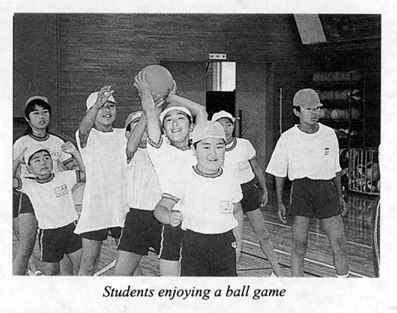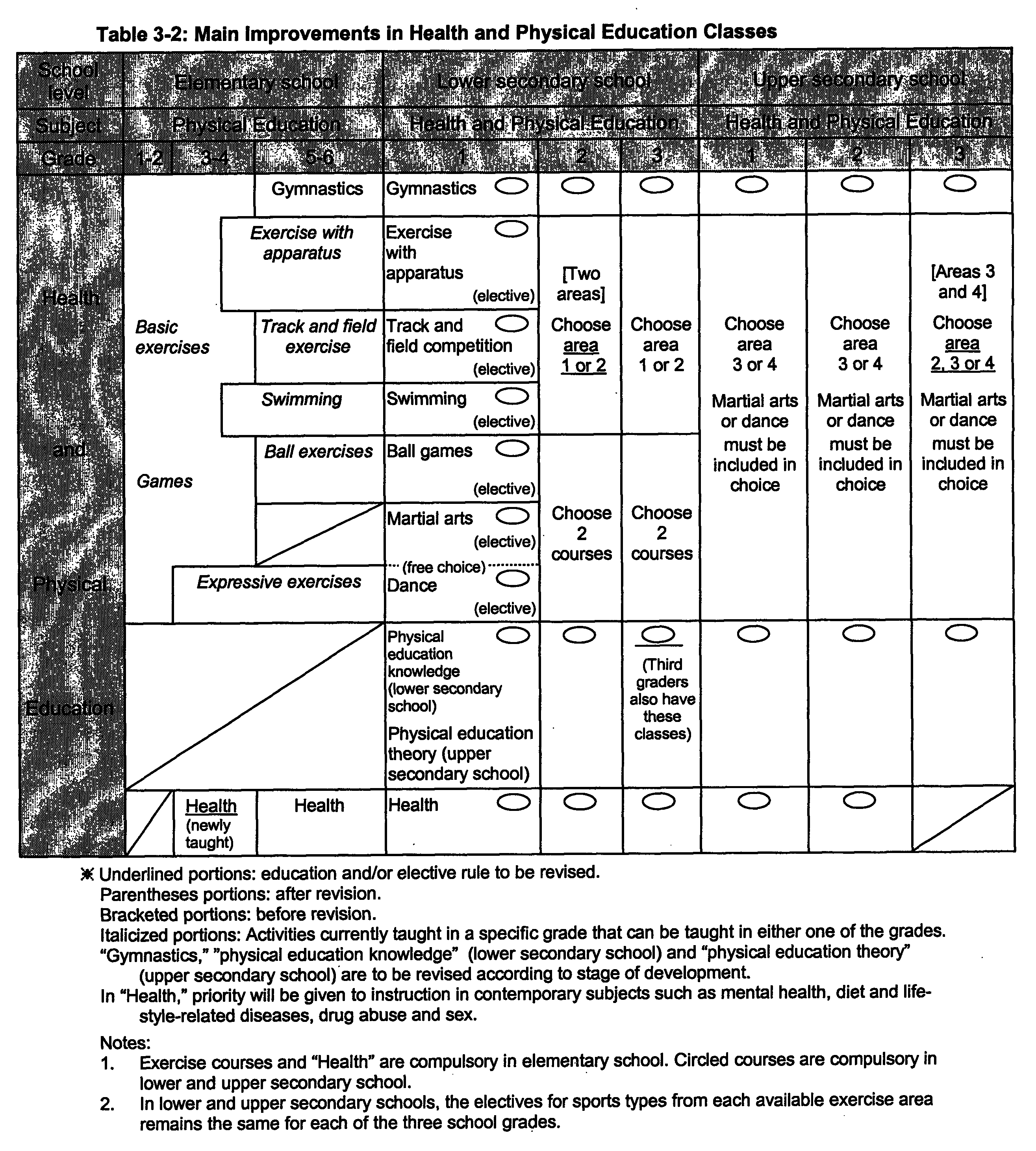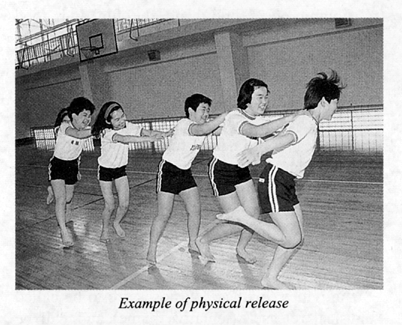| Home > Policy > White Paper, Notice, Announcement > White Paper > JAPANESE GOVERNMENT POLICIESIN EDUCATION, SCIENCE, SPORTSAND CULTURE1998 > MENTAL AND PHYSICAL HEALTH AND SPORTS CHAPTER3 SECTION2 1 | ||
In light of the recent downward trend in the stamina and ability to exercise of students,the decrease in opportunities for physical activity in daily life,the widening gap between students who are interested and actively participating in sports and those who are not,the worsening of the discipline of daily habits and the increase of stress in daily life,Physical Education in elementary school and Health and Physical Education in lower and upper secondary schools are more important than ever in building the foundation for lifelong participation in sports and in learning a healthy way of life.From this viewpoint,it is important to encourage students to acquire the strengths and abilities to enjoy exercise throughout their lives so that they may enjoy and become more skillful at exercise,in consideration of the cultivation of their basic stamina and ability to exercise so they can lead active lives.It is also necessary to give consideration to tbe balance of extracurricular sports club activities and sports at home and in communities.
According to the current Courses of Study,Health and Physical Education through elementary,lower and upper secondary schools aims to encourage students to acquire the habit of enjoying exercise on their own and then voluntarily and independently exercising in order to cultivate a foundation for physical education and sports activity throughout life,and to improve stamina and the ability to exercise.

Lower and upper secondary schools,in particular,are actively introducing"elective systems"that encourage students to choose exercise areas and types of sports in line with their respective abilities,aptitude and interests,and to pursue them voluntarily.So far the educational programs have been revised for improvement every10years or so.Through these revisions,the range of electives of exercise areas and sports types has been expanded,these areas have been reviewed and modified to better match students'development stage,and educational content has been carefully streamlined for the realization of school life with free scope.Whereas students were all required to take the same five exercise areas in elementary school and the same six areas in lower and upper secondary school throughout the late1960s,now there are"basic exercises"and"games"(integrating various exercise areas)tailored to the characteristics of students in lower and middle grades of elementary school,and other optional sports in addition to compulsory gymnastics for students from second grade lower secondary school to third grade upper secondary school.
MESSC has been conducting studies on a newprogram to begin from FY2002,based on the report of the Curriculum Council in July1998.With the full introduction of the comprehensivefive-day school week,the curriculum will call oneach school to develop educational activitieswith enough free scope to foster the"zest forliving" 1 of each and every child.
Health and Physical Education as a school subject plays a central role in cultivating"vigorous lives and a healthy body,"one of the elements of a"zest for living,"and is highly significant as a foundation for school educational activities that promote balance in the intellectual,etbical and physical aspects of students'development.In light of the stamina and ability to exercise of today's students,which has been touched on so far,the curriculum will be improved with an emphasis on measures enabling students to acquire the strengths and abilities to play sports throughout life,and with priority on acquiring healthy habits.Special efforts are being made to further link physical education and health education,relying on the notion that the importance of further integrating mind and body helps people promote sound growth.Ensuring that children have some free scope is a significant issue in each subject with the introduction of the comprehensive five-day school week.In Health and Physical Education,MESSC will carefully limit school education to the basic abilities that all students should acquire in accordance with their development stages,by studying the role and significance of families and communities.Based on the above concepts,the following improvements in Health and Physical Education were recommended in the above report.
"Zest for living"
Proposed in the first report of the Central Council for Education in July1996,"zest for living"describes the qualities and the ability to identify problem areas for themselves,to learn,think,make judgments and act independently and to be more adept at problemsolving.We also felt that they need to be imbued with a rich sense of humanity in the sense that while exercising self-control,they must be able to cooperate with others,have consideration for their needs and have a spirit that feels emotion.It also goes without saying that if they are to lead vigorous lives,a healthy body is an indispensable requirement.
(i)Developing the strengths and abilities toenjoy exercise
MESSC has long encouraged students to develop the habit of exercising on their own.These efforts must be redoubled in order to cultivate a foundation for lifelong participation in sports.Improvements will be made in line with the following viewpoints for each developmental stage.
MESSC is improving and enhancing instruction so that priority is given to developing the unique abilities and aptitude of each student through exposure to various activities,experiencing the fun and joy of those activities and selecting the activities best suited to them;students will be encouraged to develop their unique abilities and aptitude rather than acquiring the same skills as every other student.
To enable students to exercise on their own,MESSC will make efforts to enable more flexiblehandling of physical exercise according to the circumstances of individual schools and communities,while further introducing the approach of problemsolving methods through,for example,targetlearning and"elective systems"matched to developmental stage.At the elementary school level,specific activities are currently prescribed for eachgrade,but this will be made more flexible by allowing schools to allocate some activities to first orsecond grades(ages7and8),third or fourthgrades(ages9and10),and fifth or sixth grades(ages11and12),providing instruction in the activities of their choice within certain limitations.Atthe lower and upper secondary school levels,improvements will be made to allow more electivesof physical exercise areas and types.Instruction ofmore diversified activities will also be allowed inelementary,lower and upper secondary schoolsaccording to the specific circumstances of eachschool and community( see Table3-2 ).

Since today's students do not have enough chances for physical activity outdoors in close contact with the natural environment,efforts will be actively made to provide such opportunities in collaboration with other subjects,and in line with the specific circumstances of each community and school.
(ii)Improvement of stamina
Improvement of stamina has long been a goal of Health and Physical Education,but fewer opportunities for students to move their bodies in daily life has brought about a deterioration in their stamina.By taking advantage of increased opportunities for sports activities in communities,improvements will be made at each level in line with the following viewpoints:
In courses on"knowledge related to physical education"(lower secondary school)and"physical education theory"(upper secondary school),instruction will aim to further integrate theory and practice,emphasizing ways to increase stamina and ways to learn exercise based on recent findings in sports science,and leading to the development of strength and ability to enjoy exercise over a lifetime and to the improvement of stamina.
(iii)Physical release(karada-hogushi)
(a)Purpose of physical release
The decline in the stamina and ability to exercise of children and the widening gap between people who actively exercise and those who do not,mentioned earlier,is thought to be largely due to the change in the environment in which children are raised,especially the decrease in play and other forms of basic physical activity,and the mental stress experienced from day to day.Therefore,there is a need to prepare new activities aimed at the following:
Activities for these purposes are to be called"pbysical release"(tentative name)and will be carried out as a foundation for improving the strengths,abilities and stamina to enjoy exercise.This will enable both people who actively exercise and those who do not,to experience the good feeling of exercising as well as the physical and mental release it offers.
(b)Physical release activities
Physical release does not aim at setting records,mastering difficult skills or winning competitions such as in sports,but consists of rhythmic activities.Pbysical release will be newly added to the"basic exercise courses"in elementary schools and"gymnastics"in elementary,lower and upper secondary schools,while also being incorporated into other exercise areas and sports types as well as"mental health"courses.In"gymnastics,"since physical release will be newly added in accordance with improving stamina,the name will be changed to incorporate the perspective that further integrating mind and body helps people promote sound growth.
Examples of Physical ReleasePhysical release activities do not fit a fixed pattern.As long as they are in line with the above purposes,various activities can serve as physical release activities.The following examples are possible: (1)Use of exercise equipment involving free movements (2)Pair stretching(stretching with a partner) (3)Exercise based on rhythmical movement(e.g.,rhythmic gymnastics) (4)Walking and jogging at a comfortable pace (5)Story games involving simple physical activity(e.g.,throwing balls) (6)Various activities and play outdoors |

| Back to Top | MEXT HOME |